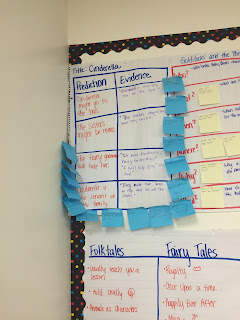I love when we learn about rhyming words. The kids always do a great job with it and we have a lot of fun. I started off this unit by using a bridge map. We thought up rhyming words together and we discussed how rhyming words are usually part of the same word family, so they are spelled the same. After we did a class bridge map the students got to make their own. They did a fantastic job and I let them be little creative with their coloring.
On day two, we played one of my favorite rhyming games. This one is by Kagan Cooperative Learning Strategies. You can get the book by clicking here. With this game each student gets a yes card and a no card. On the board or projector you show a rhyming word card with 2 pictures (shown on the left) then students raise their card to display their answer. It is always a big hit and super easy to reuse every year.
We've covered a LOT during our reading block and even though I don't have any pictures of student work for this one I do have a lovely Reading Content Wall going on for this unit. We used the 5 Ws and an H to help us learn about questions and we also used the 5 Finger Retell to summarize our folktales and fairy tales.
My district follows the Empowering Writers curriculum for writing. I have really started to love it this year as my students go deeper into the writing process. The first week of school we learned the difference between a narrative and an expository text. As you can see below, we created 2 simple anchor charts that we will continue to use all year to reiterate the difference between the two types of genre. We also learned a cute song called "Discover the Cover" to help us remember to check the cover for hints.
After we learned the 2 types of genre the students got a chance to come up with their own narrative and expository cover. Each child created 2 book covers. The first cover was a narrative cover of any story they would like. On the inside, students wrote what the text was about, the problem and solution and what the author's purpose was. On day two, they created an expository cover that mirrored their narrative story.
Looking back we have done a lot in the first 3 1/2 weeks of school! We still have much to learn, but I feel confident that these students will be more than ready for 2nd grade (yes, I'm already thinking about them moving on! Begin with the end in mind).
On day two, we played one of my favorite rhyming games. This one is by Kagan Cooperative Learning Strategies. You can get the book by clicking here. With this game each student gets a yes card and a no card. On the board or projector you show a rhyming word card with 2 pictures (shown on the left) then students raise their card to display their answer. It is always a big hit and super easy to reuse every year.
We've covered a LOT during our reading block and even though I don't have any pictures of student work for this one I do have a lovely Reading Content Wall going on for this unit. We used the 5 Ws and an H to help us learn about questions and we also used the 5 Finger Retell to summarize our folktales and fairy tales.
My district follows the Empowering Writers curriculum for writing. I have really started to love it this year as my students go deeper into the writing process. The first week of school we learned the difference between a narrative and an expository text. As you can see below, we created 2 simple anchor charts that we will continue to use all year to reiterate the difference between the two types of genre. We also learned a cute song called "Discover the Cover" to help us remember to check the cover for hints.
The next week we begin exploring prompts and making circle maps. Here is my modeled circle map below and a few student examples. I encourage students to write as many words as possible in their circle maps, but for those who need the extra support I also allow them to draw pictures and label.
After a week of practicing circle maps together I now have my students creating their own circle maps in centers. They have done really well with them and I'm excited to see what stories they create later!!!
Looking back we have done a lot in the first 3 1/2 weeks of school! We still have much to learn, but I feel confident that these students will be more than ready for 2nd grade (yes, I'm already thinking about them moving on! Begin with the end in mind).

























No comments:
Post a Comment